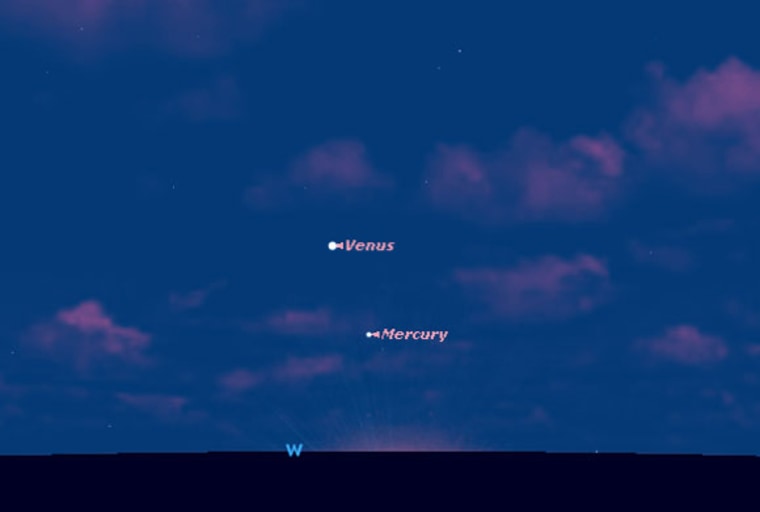A Pas de Deux is French for "Step of Two" and is what partnering is called in ballet. By dancing with a partner the lady can jump higher, and "float" about the stage as she is carried by her male partner. And from now through mid April, a celestial Pas de Deux will be enacted in the western evening twilight sky as the "Queen of the Night," the brilliant planet Venus, will engage the normally hard-to-find planet Mercury.
Through a run that will last more than two weeks, skywatchers will be able to watch as Venus seemingly "floats" above and to the left of Mercury. The two planets will gradually draw together, then slowly they will separate, Mercury ultimately fading from view. It should be a fantastic sight if skies are clear and you know where to look.
Isaac Asimov (1920-1992), a writer of science and science fiction, once commented that the planet Mercury is rarely visible when it is truly dark.
"I suspect, in fact," he wrote, "that many people today (when the horizon is generally much dirtier and the sky much hazier with the glare of artificial light than it was in centuries past) have never seen Mercury."
Mercury is indeed clever at escaping detection. It is said that the famous astronomer Copernicus never saw this planet from his native Poland — more than likely an apocryphal tale.
You can find it, though. It's all in knowing how. The closest planet to the Sun, it is usually masked by the Sun's glare, so one always must look for Mercury either soon after sunset, or just before sunrise.
Let Venus be your guide
About a half-hour after sunset, using binoculars, scan near to the west-northwest horizon to locate Mercury.
Although shining at magnitude – 1.3, which is virtually as bright as Sirius (the brightest star in the sky), Mercury is still deeply immersed in the bright evening twilight so it will be rather difficult to pick out.
But this unfavorable circumstance will rapidly change in the coming days, for although it will slowly fade, this will be more than compensated by the fact that it will be pulling farther away from the sun and correspondingly lifting higher up into the sky. Also take note how Mercury will appear to approach Venus, moving up toward it from Venus' lower right.
In fact, between March 28 and April 12, Mercury will be within 5 degrees of Venus (your clenched fist held at arm's length measures approximately 10 degrees).
So Venus will serve as a convenient guidepost to locate this normally hard-to-find planet. About 30 to 45 minutes after sunrise look low toward the west-northwest horizon. You will immediately spot brilliant Venus. Hovering below and to its right you will see a bright yellowish "star." You're looking at our solar system's so-called "elusive" planet.
A 'quasi-conjunction'
In fact, this will be Mercury's very best showing of the year for those who are located north of the equator ... better than even this year's best pre-sunrise apparition (which will occur in late September). And since also more people are interested in looking for Mercury in the dusk than in the dawn, the dusks of late March through the first half of April are the ones to plan on.
On the evening of April 3, Venus and Mercury will appear closest together, just a little over 3 degrees apart. Though it will be shining brilliantly at a magnitude of -0.6, Mercury still appears only 1/21 as bright as Venus, which literally dazzles at magnitude -3.9. Thereafter, the two planets will very slowly separate.
Interestingly, this is not a conjunction between these two planets...at least in the "official" sense. At no time do Mercury and Venus have the same right ascension or ecliptic longitude.
But the famed Belgian calculator, Jean Meeus calls this a "quasi-conjunction" (when two objects coming to less than 5 degrees apart without having a true conjunction). In the "2010 Astronomical Calendar," Fred Schaaf notes that this is the "first quasi-conjunction of bright planets since 2006 and it lasts a number of days."
From our Earthly vantage point, Mercury will be sweeping around in its orbit, eventually taking it between us and the sun. So its phase will be waning, going from gibbous, to half illuminated, to a crescent. And as its disk becomes less illuminated, it will correspondingly fade in brightness.
Indeed on April 8, Mercury will appear only half as bright as it appeared five days ago while arriving at its greatest elongation, just 19 degrees east of the Sun. But for those situated at north-temperate latitudes these early-spring elongations are when, during evening twilight, Mercury appears to stand almost directly over that point on the west-northwest horizon where the sun has set.
So this is when it shines highest during dusk. After this evening, Mercury will start descending into the twilight glow, while fading dramatically.
I'm guessing that the evening of April 15 will probably be the last chance for most people to get a glimpse of Mercury. Half an hour after sunset, concentrate about 10 degrees (about "one-fist") above the west-northwest horizon. Binoculars will be a big help. First, scan for a hairline crescent moon, only about 36-hours past new phase. About 1 degree below and to the left of the moon will be Mercury, having faded to magnitude +1.5.
By the next night, Mercury will have vanished into the sunset fires and the dance will have ended.
